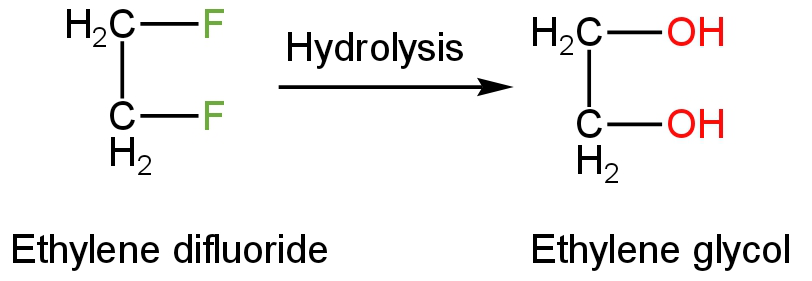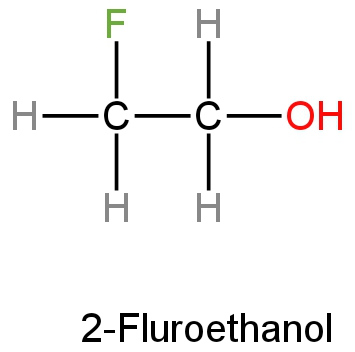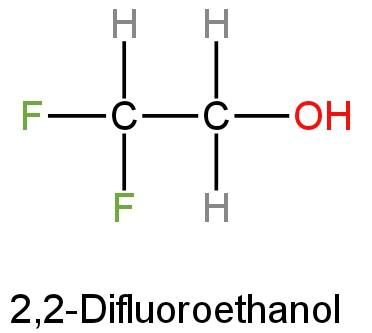
Ethylene difluoride on hydrolysis gives
A. Glycol
B. Fluoroethanol
C. Difluoroethanol
D. Freon
Answer
223.2k+ views
Hint: Hydrolysis is a chemical interaction in which a water molecule breaks down one or more chemical bonds. Water acts as a nucleophile in this reaction.
Complete Step by Step Solution:
Ethylene difluoride or 1,2-difluoro ethane is a fluorinated hydrocarbon.
In the hydrolysis of ethylene difluoride, the carbon-fluorine bond is broken down.
A. Glycol
It is also known as ethylene glycol.
The chemical formula is \[{\left( {{\rm{C}}{{\rm{H}}_{\rm{2}}}{\rm{OH}}} \right)_{\rm{2}}}\].
When ethylene difluoride is treated with water, the hydroxide ions act as a nucleophile.
These hydroxide ions attack the reactant and replace the fluoride ions.
Two hydroxide ions replace two fluoride ions.

Image: Hydrolysis of ethylene difluoride
The product formed is a liquid having no odour or colour, sweet taste, explosive, dense liquid.
So, A is correct.
B. Fluoroethanol
2-Fluoroethanol is an organic compound with the chemical formula \[{\rm{C}}{{\rm{H}}_2}{\rm{FC}}{{\rm{H}}_2}{\rm{OH}}\].
This is a liquid with no colour and is one of the simple stable fluorinated alcohols.
Its structure is as follows:

Image: 2-Fluoroethanol
In the hydrolysis of ethylene difluoride, both the fluorine atoms are replaced by hydroxide ions.
So, this is not the product of the hydrolysis of ethylene difluoride.
So, B is incorrect.
C. Difluoroethanol
Difluoroethanol is an organic compound with the chemical formula \[{\rm{C}}{{\rm{F}}_2}{\rm{HC}}{{\rm{H}}_2}{\rm{OH}}\].
This is a liquid with no colour and is one of the simple stable fluorinated alcohols.
Its structure is as follows:

Image: Difluoroethanol
In the hydrolysis of ethylene difluoride, both the fluorine atoms are replaced by hydroxide ions.
So, this is not the product of the hydrolysis of ethylene difluoride.
So, C is incorrect.
D. Freon
Chlorofluoro compounds of methane and ethane in which all the hydrogen atoms are replaced by halogen atoms are altogether known as freons.
There are different types of freons depending on the number of fluorine atoms present in them.
For example,
\[{\rm{C}}{{\rm{F}}_{\rm{4}}}\] or Freon-14,
\[{\rm{C}}{{\rm{F}}_{\rm{2}}}{\rm{C}}{{\rm{l}}_{\rm{2}}}\] or Freon-12, \[{\rm{CFC}}{{\rm{l}}_{\rm{3}}}\] or Freon-11.
In the hydrolysis of ethylene difluoride, both the fluorine atoms are replaced by hydroxide ions.
So, this is not the product of hydrolysis of ethylene difluoride.
So, D is incorrect.
So, option A is correct.
Note: While attending to the question, one must remember that the hydrolysis of ethylene difluoride involves the breaking of the carbon-fluorine bond. New carbon-oxygen bonds are formed. A rough idea about the chemical structure of all the given options must be there.
Complete Step by Step Solution:
Ethylene difluoride or 1,2-difluoro ethane is a fluorinated hydrocarbon.
In the hydrolysis of ethylene difluoride, the carbon-fluorine bond is broken down.
A. Glycol
It is also known as ethylene glycol.
The chemical formula is \[{\left( {{\rm{C}}{{\rm{H}}_{\rm{2}}}{\rm{OH}}} \right)_{\rm{2}}}\].
When ethylene difluoride is treated with water, the hydroxide ions act as a nucleophile.
These hydroxide ions attack the reactant and replace the fluoride ions.
Two hydroxide ions replace two fluoride ions.

Image: Hydrolysis of ethylene difluoride
The product formed is a liquid having no odour or colour, sweet taste, explosive, dense liquid.
So, A is correct.
B. Fluoroethanol
2-Fluoroethanol is an organic compound with the chemical formula \[{\rm{C}}{{\rm{H}}_2}{\rm{FC}}{{\rm{H}}_2}{\rm{OH}}\].
This is a liquid with no colour and is one of the simple stable fluorinated alcohols.
Its structure is as follows:

Image: 2-Fluoroethanol
In the hydrolysis of ethylene difluoride, both the fluorine atoms are replaced by hydroxide ions.
So, this is not the product of the hydrolysis of ethylene difluoride.
So, B is incorrect.
C. Difluoroethanol
Difluoroethanol is an organic compound with the chemical formula \[{\rm{C}}{{\rm{F}}_2}{\rm{HC}}{{\rm{H}}_2}{\rm{OH}}\].
This is a liquid with no colour and is one of the simple stable fluorinated alcohols.
Its structure is as follows:

Image: Difluoroethanol
In the hydrolysis of ethylene difluoride, both the fluorine atoms are replaced by hydroxide ions.
So, this is not the product of the hydrolysis of ethylene difluoride.
So, C is incorrect.
D. Freon
Chlorofluoro compounds of methane and ethane in which all the hydrogen atoms are replaced by halogen atoms are altogether known as freons.
There are different types of freons depending on the number of fluorine atoms present in them.
For example,
\[{\rm{C}}{{\rm{F}}_{\rm{4}}}\] or Freon-14,
\[{\rm{C}}{{\rm{F}}_{\rm{2}}}{\rm{C}}{{\rm{l}}_{\rm{2}}}\] or Freon-12, \[{\rm{CFC}}{{\rm{l}}_{\rm{3}}}\] or Freon-11.
In the hydrolysis of ethylene difluoride, both the fluorine atoms are replaced by hydroxide ions.
So, this is not the product of hydrolysis of ethylene difluoride.
So, D is incorrect.
So, option A is correct.
Note: While attending to the question, one must remember that the hydrolysis of ethylene difluoride involves the breaking of the carbon-fluorine bond. New carbon-oxygen bonds are formed. A rough idea about the chemical structure of all the given options must be there.
Recently Updated Pages
JEE General Topics in Chemistry Important Concepts and Tips

JEE Extractive Metallurgy Important Concepts and Tips for Exam Preparation

JEE Atomic Structure and Chemical Bonding important Concepts and Tips

JEE Amino Acids and Peptides Important Concepts and Tips for Exam Preparation

Electricity and Magnetism Explained: Key Concepts & Applications

JEE Energetics Important Concepts and Tips for Exam Preparation

Trending doubts
JEE Main 2026: City Intimation Slip Expected Soon, Application Form Closed, Exam Dates, Syllabus & Eligibility

JEE Main 2026 Application Login: Direct Link, Registration, Form Fill, and Steps

Understanding the Angle of Deviation in a Prism

How to Convert a Galvanometer into an Ammeter or Voltmeter

Ideal and Non-Ideal Solutions Explained for Class 12 Chemistry

Hybridisation in Chemistry – Concept, Types & Applications

Other Pages
JEE Advanced Marks vs Ranks 2025: Understanding Category-wise Qualifying Marks and Previous Year Cut-offs

Organic Chemistry Some Basic Principles And Techniques Class 11 Chemistry Chapter 8 CBSE Notes - 2025-26

Hydrocarbons Class 11 Chemistry Chapter 9 CBSE Notes - 2025-26

Equilibrium Class 11 Chemistry Chapter 6 CBSE Notes - 2025-26

Redox Reaction Class 11 Chemistry Chapter 7 CBSE Notes - 2025-26

Degree of Dissociation: Meaning, Formula, Calculation & Uses




